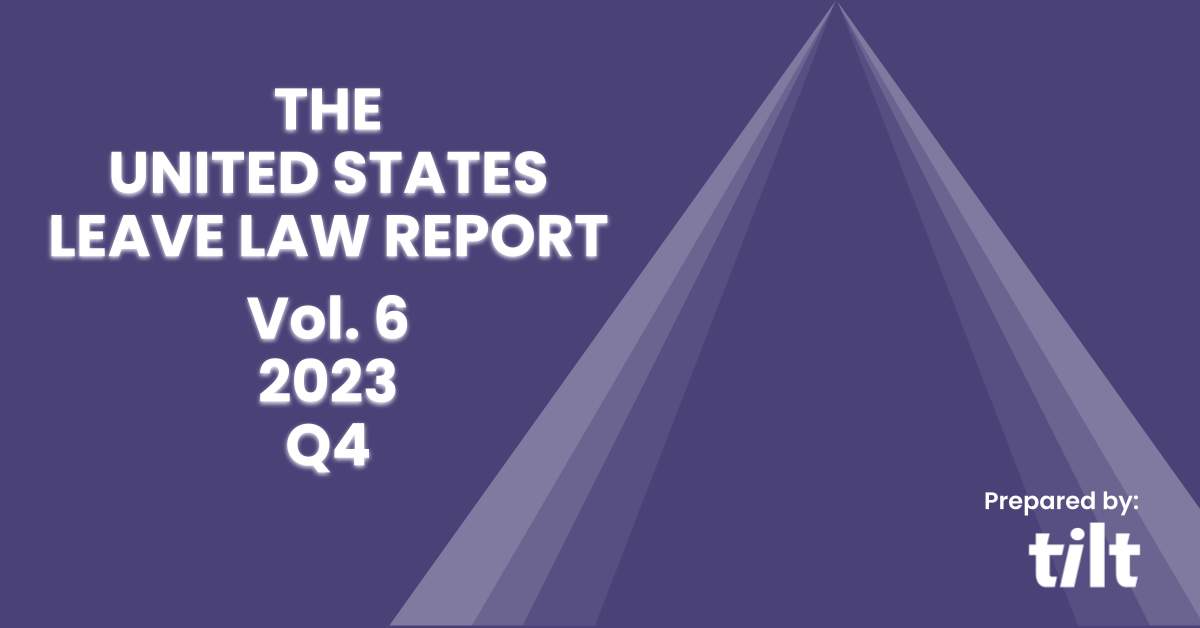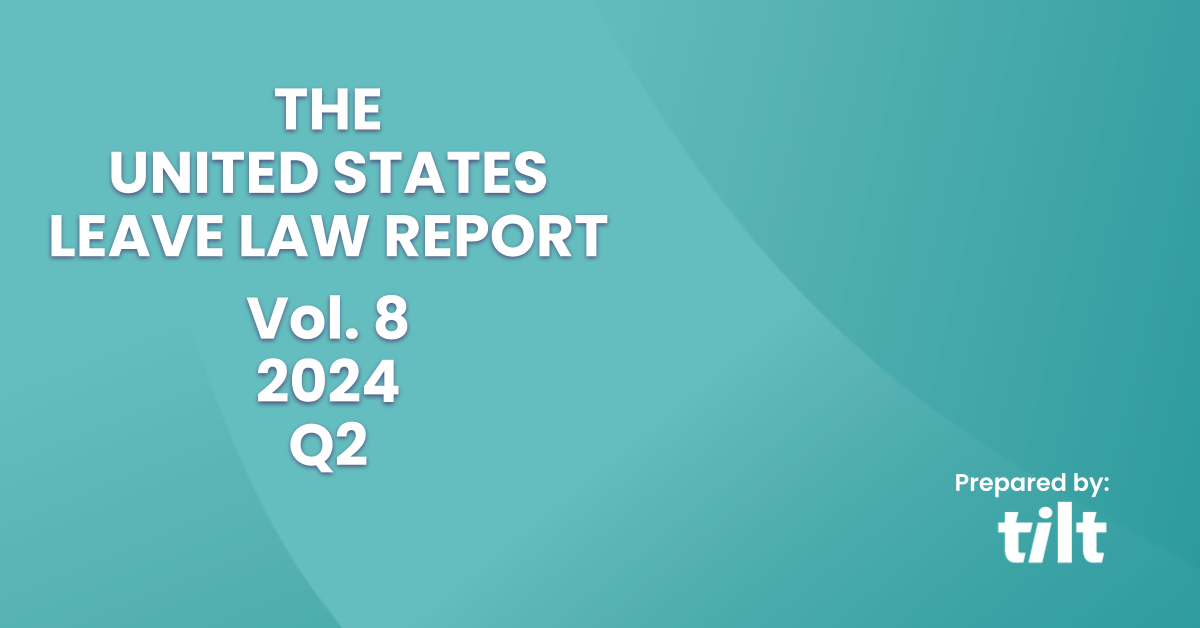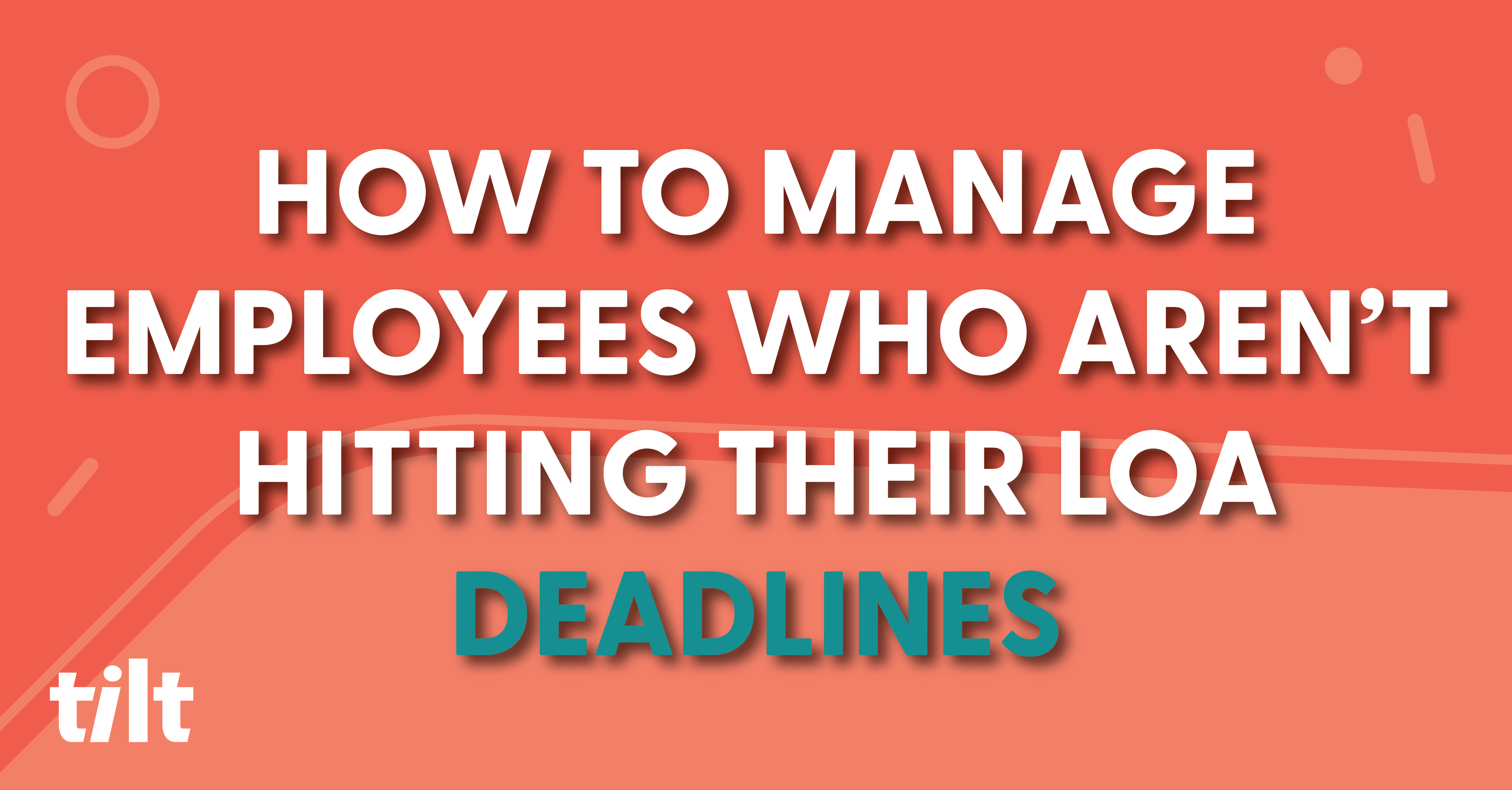Time flies when you’re neck deep keeping your organization’s ship on course, but while you’re strapping on your People Ops cape and putting out fires, the ever-changing world of leave laws marches onward.
But fret not, because Tilt’s team of leave law experts keep tabs ‘round the clock and have you covered.
The United States Leave Law Report: Vol. 6 details the latest updates to leave programs that might impact you and your organization in one sweet lil’ package.
We hope you find this information useful in your pursuit of supporting your employees and staying compliant!
Looking for all the insightful goodies from previous volumes? See what you might have missed here.
Federal Legislation: Paid Family & Medical Leave
TL;DR: Bipartisan group aims to dispel notion that “Congress” is the opposite of “progress” when it comes to paid leave
The United States is one of a handful of countries–and the only OECD member–without a national paid family leave policy. To address that deficiency, House Democrats and Republicans formed a Bipartisan Paid Family Leave Working Group. The working group wrapped up its information-gathering meetings with stakeholders last month. The group will now shift its focus to developing legislation–but given the current political climate, it’s unclear whether they will be able to find a solution that will work for both parties. In the meantime, states continue to launch their own paid leave programs, each with different rules and benefits. If Congress does pass a federal paid leave law, it probably won’t relieve employers from the need to comply with the requirements of existing state programs. So, the complexity is here to stay.
National Protections: Pregnant Workers Fairness Act
TL;DR: PWFA regulations conceived but require further gestation
On June 27, 2023, the national Pregnant Workers Fairness Act (PWFA) went into effect. The PWFA requires covered employers to reasonably accommodate employees with known limitations related to pregnancy, childbirth or related medical conditions. We started tracking leave as an accommodation under the PWFA when the law went live.
On August 7, the Equal Employment Opportunity Commission (EEOC) shared its proposed PWFA regulations, which provide a framework for understanding how the EEOC will interpret the law. The key provisions of this 275-page document are summarized on the EEOC website. The EEOC collected comments from stakeholders after publishing the proposed rules, and it will review and analyze that feedback as it works towards publishing final regulations by the end of the year.
State PFML Programs: Overview
TL;DR: A state of calm in Q3 for state legislatures
After a flurry of new state-paid family and medical leave (PFML) laws passed in the first half of 2023, state legislatures were relatively quiet in Q3.
As previously reported, thirteen states (and Washington D.C.) have enacted mandatory PFML laws. These mandatory programs are funded through payroll taxes (except for NY) and guarantee partial wage replacement benefits to eligible employees who work for a covered employer and need leave for a qualifying reason.
Mandatory PFML benefits are currently available in California, Connecticut, Massachusetts, New Jersey, New York, Oregon, Rhode Island, Washington and Washington D.C. Benefits will be available in Colorado in 2024 and in Delaware, Maine, Maryland and Minnesota in 2026.
In addition, eight states have enacted “voluntary PFML” laws that permit, but do not require, employers or employees to purchase PFML insurance as a private market product: Alabama, Arkansas, Florida, New Hampshire, Tennessee, Texas, Virginia and Vermont.
State PFML Programs: Updates
Oregon
TL;DR: Oregon’s new PFML program is live but not lively
Paid Leave Oregon officially launched on September 3rd. Eligible employees can receive up to 12 weeks of paid leave per year for family, medical and safety reasons, with an additional two weeks available in some pregnancy-related situations. Most Oregon workers will be eligible for paid benefits, as the earnings threshold is low ($1,000 in the prior year).
Oregon received about 19,000 applications for its Paid Leave Oregon program in its first month, which was less than half of what it had predicted. By the end of September, the state had approved approximately half of all claims filed, paying roughly $15 million in benefits. The state has been working on its efficiency, increasing its speed in processing applications by 162% since launch.
Colorado
TL;DR: Colorado will open FAMLI application process early to avoid rocky start
Colorado’s Family and Medical Leave Insurance (FAMLI) program will start paying benefits to eligible employees beginning January 1, 2024. Colorado will reportedly begin accepting applications in mid-November to help avoid a backlog in January. When the online FAMLI application becomes available, we’ll provide application instructions to eligible employees who have leave scheduled for 2024.
Under the FAMLI program, eligible employees can receive up to 12 weeks of paid leave for certain family, medical, military and safety reasons, and up to 16 weeks if the employee has complications related to pregnancy or childbirth. Most workers in Colorado will be eligible for paid FAMLI benefits, as the eligibility threshold is only $2,500 in wages earned in Colorado within a year. Employees can receive up to 90% of their wages, subject to a cap (currently $1,100/week).
In recent developments, the FAMLI Division modified its definition of “wages” to align it with the Unemployment Insurance Division’s definition, effective January 1, 2024. The Division amended the definition in response to complaints that it was previously too complicated.
For more information on the FAMLI program, check out the Division’s helpful toolkit for employers.
Delaware
TL;DR: Be aware of Delaware’s PFML deadline for grandfathering existing plans
Employers with ten or more employees working in Delaware will be required to participate in the state’s PFML program when it goes live in 2026.
Through the end of 2023, Delaware is giving employers a unique “grandfathering” opportunity. Employers with existing private paid time off benefits comparable to Delaware’s program can apply to use those benefits to meet their paid leave obligations instead of contributing to the state plan. The benefits must have been in place as of May 10, 2022, and must be within 10% of the minimum requirements of the state program to be considered “comparable.” You can read more about this option in the state’s Grandfathered Paid Leave Benefits FAQ.
Another option for covered employers is to use an approved private benefit plan purchased from an insurance company or administered through a self-insured plan. The private plan must have the same or better benefits as the state plan. The first opt-in period for a private plan will be September 1, 2024 through December 1, 2024.
For covered employers without a grandfathered or private plan, contributions to the program will begin on January 1, 2025.
Maryland
TL;DR: Maryland sets rate for contributions beginning 10/1/24
Maryland’s Family and Medical Leave Insurance (FAMLI) plan goes live in 2026 and applies to all employers with at least one employee working in Maryland.
On September 29, the Maryland Department of Labor approved the initial plan contribution rate of 0.9% of covered wages, divided equally between employees and employers with 15 or more employees.
Maryland’s DOL will establish implementing rules and regulations in early 2024. Employers can seek approval for a private plan in fall 2024, and contributions for those enrolled in the state plan begin on October 1, 2024.
Washington
TL;DR: Washington reports rainy weather, possible storms on horizon for PFML program
Washington recently released a report on its PFML program’s needs and resources. Since its launch in 2020, the program has distributed over $3.4 billion in leave benefits to over 382,000 Washington employees. However, an increase in benefit applications has led to increased phone queue times (31.5 minutes in July 2023 vs. 12.5 minutes in July 2022) and application approval times (a median of over four weeks in July 2023 vs. 2.5 weeks in July 2022). The state Employment Security Department (ESD) is seeking budget authority to hire additional staff to address the increase in volume. Without more staff, the ESD projects that application processing times could reach four months by June 2025.
Stories to Watch
TL;DR: Michigan and New Mexico are our best bets to mandate PFML next
Michigan currently offers 12 weeks of paid parental leave to state employees, and conditions are favorable for expanding benefits to employees in the private sector. Michigan has a trifecta with its Democratic governor and Democratic control of both state legislature chambers for the first time since the Reagan administration. Legislators have already introduced multiple PFML bills, and Governor Whitmer has publicly announced her support for PFML expansion.
New Mexico nearly passed a PFML law last year–the bill passed the state Senate but died in a House committee when a few Democrats aligned with Republicans in a vote to table the issue in the final week of the session. The 2024 bill looks similar but includes some concessions to the local business community, and policymakers are hosting town halls to educate the community and win further support.
Other Leave Law Updates - Quick Hits
Massachusetts – November 1, 2023 changes
- MA PFML top up permitted: Effective November 1, Massachusetts will permit employees to top up their MA PFML benefits using any available accrued paid leave, such as sick time or vacation pay. Previously, employees in MA could only use their accrued paid leave during their 7-day waiting period. Massachusetts now joins all the other mandatory PFML states in permitting employees to top up state payments with accrued PTO.
California – January 1, 2024 changes
- SDI wage cap lifted: California’s SDI program provides partial wage replacement benefits for employees who need time off work for a non-work-related illness or injury, or for certain family caregiving and new child bonding reasons. For 2023, the SDI withholding rate is 0.9% on covered wages up to $153,164. In January, the state will remove the taxable wage ceiling so that all wages will be subject to CA SDI tax. The additional tax revenue generated will fund an increase in SDI benefit rates/amounts in 2025.
- Reproductive loss leave: Eligible employees will be able to take up to 5 days of unpaid time off for a “reproductive loss event,” which includes loss related to adoption, surrogacy, miscarriage, stillbirth, or an unsuccessful assisted reproduction. Eligible employees can take these days within three months of the reproductive loss event and do not need to take them continuously.
- Expansion of paid sick days: California amended its sick leave law to increase the minimum number of paid sick days from three to five. The amendments also modify accrual, carryover and frontloading provisions.
Illinois – January 1, 2024 changes
- Organ donation: Illinois will expand its blood donation act to include organ donation.
- Bereavement expansion: Illinois will expand its bereavement leave act to require additional weeks of unpaid leave for eligible employees who lose a child by suicide or homicide. Illinois has also amended its Victims Economic Security and Safety Act (VESSA) to require unpaid leave related to the death of a family or household member killed in a crime of violence.
- Paid Leave for All Workers Act (PLFAW): This new law requires employers to provide 40 hours of PTO for any reason in a 12-month period; the state FAQ is a helpful resource.
Thank you for your interest in learning more about the latest leave laws impacting states across the country! At Tilt, we live and breathe all things leave and are passionate about supporting and educating everyone on the importance of empathetic and compassionate leaves of absence. If you have any questions about the latest leave laws or about how to better support your people when they need a leave…drop us a line.
About Tilt
Tilt is leading the charge in all things leave of absence management through easy-to-use tech and human touch. Since 2017, our proprietary platform and Empathy Warriors have been helping customers make leave not suck by eliminating administrative burdens, keeping companies compliant, and providing a truly positive and supportive leave of absence experience for their people.







